Seasonal Characteristics and Particle-size Distributions of Particulate Air Pollutants in Urumqi
Abstract
:1. Introduction
2. Material and Methods
3. Results and Discussion
3.1. Annual Variations in PM10 Concentration
3.2. Average Monthly Variations in PM10 Concentration
3.3. Seasonal Variations in PM10 Concentration
3.4. Diurnal Variations in PM10, PM2.5 and PM1.0 Mass Concentrations
3.5. Seasonal and Monthly Average Ratios of PM2.5/PM10, PM1.0/PM10 and PM1.0/PM2.5
3.6. Distribution Characteristics of Aerosol Particles within Each Size Interval in Urumqi
4. Conclusions
Supplementary Materials
Author Contributions
Funding
Conflicts of Interest
References
- Porter, J.N.; Clarke, A.D. Aerosol size distribution models based on in situ measurements. J. Geophys. Res. Atmos. 1997, 102, 6035–6045. [Google Scholar] [CrossRef] [Green Version]
- Barthelmie, R.J.; Pryor, S.C. Implications of ammonia emissions for fine aerosol formation and visibility impairment: A case study from the Lower Fraser Valley, British Columbia. Atmos. Environ. 1998, 32, 345–352. [Google Scholar] [CrossRef]
- Sánchez-Ccoyllo, O.R.; Fátima Andrade, M. The influence of meteorological conditions on the behavior of pollutants concentrations in São Paulo, Brazil. Environ. Pollut. 2002, 116, 257–263. [Google Scholar] [CrossRef]
- Chow, J.C.; Watson, J.G.; Fujita, E.M. Temporal and spatial variations of PM2.5 and PM10 aerosol in the Southern California air quality study. Atmos. Environ. 1994, 28, 2061–2080. [Google Scholar] [CrossRef]
- Wang, Y.; Zhuang, G.; Sun, Y. The variation of characteristics and formation mechanisms of aerosols in dust, haze, and clear days in Beijing. Atmos. Environ. 2006, 40, 6579–6591. [Google Scholar] [CrossRef]
- Seaman, N.L. Meteorological modeling for air-quality assessments. Atmos. Environ. 2000, 34, 2231–2259. [Google Scholar] [CrossRef]
- Chan, Y.C.; Simpson, R.W.; Mctainsh, G.H.; Vowles, P.D.; Cohen, D.D.; Bailey, G.M. Source apportionment of PM2.5 and PM10 aerosols in Brisbane (Australia) by receptor modelling. Atmos. Environ. 1999, 33, 3251–3268. [Google Scholar] [CrossRef]
- Sawant, A.A.; Na, K.; Zhu, X.; Iii, D.R.C. Chemical characterization of outdoor PM2.5 and gas-phase compounds in Mira Loma, California. Atmos. Environ. 2004, 38, 5517–5528. [Google Scholar] [CrossRef]
- Lu, X.; Lin, C.; Li, W.; Chen, Y.; Huang, Y.; Fung, J.C.H. Analysis of the adverse health effects of PM2.5 from 2001 to 2017 in china and the role of urbanization in aggravating the health burden. Sci. Total Environ. 2019, 652, 683–695. [Google Scholar] [CrossRef]
- Roberto, S.R.; Luis, J.L.; Libia, P.; Maria, G.B.R. Effects of climate change on the health of citizens modelling urban weather and air pollution. Energy 2018, 165, 53–62. [Google Scholar]
- Zhang, C.; Quan, Z.Y.; Wu, Q.C.; Jin, Z.Z.; Joseph, H.; Lee, J.; Li, C.H.; Zheng, Y.X.; Cui, L.H. Association between Atmospheric Particulate Pollutants and Mortality for Cardio-Cerebrovascular Diseases in Chinese Korean Population: A Case-Crossover Study. Int. J. Environ. Res. Public Health 2018, 15, 2835. [Google Scholar] [CrossRef] [PubMed]
- Elmes, M.; Gasparon, M. Sampling and single particle analysis for the chemical characterisation of fine atmospheric particulates: A review. J. Environ. Manag. 2017, 202, 137–150. [Google Scholar] [CrossRef] [PubMed]
- Sungroul, K.; Sol, Y.; Dongmin, Y. Spatiotemporal association of real-time concentrations of black carbon (BC) with fine particulate matters (PM2.5) in urban hotspots of South Korea. Int. J. Environ. Res. Public Health 2017, 14, 1350. [Google Scholar]
- Li, L.; Lei, Y.; Pan, D.; Yu, C.; Si, C. Economic evaluation of the air pollution effect on public health in China’s 74 cities. SpringerPlus 2016, 5, 402. [Google Scholar] [CrossRef] [PubMed]
- Schiavon, M.; Redivo, M.; Antonacci, G. Assessing the air quality impact of nitrogen oxides and benzene from road traffic and domestic heating and the associated cancer risk in an urban area of Verona (Italy). Atmos. Environ. 2015, 120, 234–243. [Google Scholar] [CrossRef]
- Cristina, M.; Marco, C.; Emilio, G. Secondary particulate matter originating from an industrial source and its impact on population health. Int. J. Environ. Res. Public Health 2015, 12, 7667–7681. [Google Scholar]
- Schiavon, M.; Antonacci, G.; Rada, E.C.; Ragazzi, M.; Zardi, D. Modelling human exposure to air pollutants in an urban area. Rev. Chim. 2014, 65, 61–64. [Google Scholar]
- O’Connor, S.; O’Connor, P.F.; Feng, H.A.; Ashley, K. Gravimetric analysis of particulate matter using air samplers housing internal filtration capsules. Gefahrst. Reinhalt. Luft 2014, 74, 403–410. [Google Scholar] [PubMed]
- Vincenzo, T.; Massimo, R.; Sabrina, C.; Elena, C.; Marco, R.; Gabriela, I.; Tiberiu, A.; Adrian, B. Application of strategies for particulate matter reduction in urban areas: An Italian case. UPB Sci. Bull. Ser. D Mech. Eng. 2013, 75, 221–228. [Google Scholar]
- Gabriela, I.; Tiberiu, A.; Elena, C.; Rada, M.; Vincenzo, T. Critical analysis of strategies for PM reduction in urban areas. UPB Sci. Bull. Ser. D Mech. Eng. 2013, 75, 175–186. [Google Scholar]
- Clark, N.A.; Allen, R.W.; Hystad, P.; Wallace, L.; Dell, S.D.; Foty, R.; Dabek-Zlotorzynska, E.; Evans, G.; Wheeler, A.J. Exploring variation and predictors of residential fine particulate matter infiltration. Int. J. Environ. Res. Public Health 2010, 7, 3211–3224. [Google Scholar] [CrossRef] [PubMed]
- Mintz, D. Technical Assistance Document for the Reporting of Daily Air Quality—The Air Quality Index (AQI). Tech. Research Triangle Park, US Environmental Protection Agency. Catalogue of Rules and Regulations of Urumqi Municipal People’s Government. 2009. Available online: http://www.urumqi.gov.cn/gk/gzzd/gzzd/345058.htm (accessed on 17 April 2017).
- Royalty, T.M.; Phillips, B.N.; Dawson, K.W.; Reed, R.; Meskhidze, N.; Petters, M.D. Aerosol properties observed in the subtropical north pacific boundary layer. J. Geophys. Res. Atmos. 2017, 122, 9990–10012. [Google Scholar] [CrossRef]
- Shen, R.; Klaus, S.; Jürgen, S.K.; Shao, L.; Norra, S.; Kramar, U.; Bernhard, M.; Gülcin, A.; Thorsten, S.; Ralf, Z.; et al. Seasonal variability and source distribution of haze particles from a continuous one-year study in Beijing. Atmos. Pollut. Res. 2018, 9, 627–633. [Google Scholar] [CrossRef]
- Wang, G.; Deng, T.; Tan, H.; Liu, X.; Yang, H. Research on aerosol profiles and parameterization scheme in southeast China. Atmos. Environ. 2016, 140, 605–613. [Google Scholar] [CrossRef]
- Xia, Y.; Tao, J.; Zhang, L.; Zhang, R.; Li, S.; Wu, Y.K.; Xiong, Z. Impact of size distributions of major chemical components in fine particles on light extinction in urban Guangzhou. Sci. Total Environ. 2017, 587, 240–247. [Google Scholar] [CrossRef] [PubMed]
- Zhang, J.; Reid, J.S.; Alfaro-Contreras, R.; Xian, P. Has china been exporting less particulate air pollution over the past decade? Geophys. Res. Lett. 2017, 44, 2941–2948. [Google Scholar] [CrossRef]
- Sindosi, O.A.; Katsoulis, B.D.; Bartzokas, A. An objective definition of air mass types affecting Athens, Greece; the corresponding atmospheric pressure patterns and air pollution levels. Environ. Technol. 2003, 24, 947–962. [Google Scholar] [CrossRef] [PubMed]
- James, F.S.; Malm, W.C. The relative importance of soluble aerosols to spatial and seasonal trends of impaired visibility in the United States. Atmos. Environ. 1994, 28, 851–862. [Google Scholar]
- MEP. Technical Regulation on Ambient Air Quality Index (on Trial). Available online: http://kjs.mee.gov.cn/hjbhbz/bzwb/jcffbz/201203/W020120410332725219541.pdf (accessed on 1 January 2016).
- Jin, L.; Wei, Z. The influence of the environment and clothing on human exposure to ultraviolet light. PLoS ONE 2015, 10, e0124758. [Google Scholar]
- Real-Time Air Quality Index (AQI) Monitoring Network. Available online: http://aqicn.org/city/wulumuqi (accessed on 11 March 2003).
- Chow, J.C.; Watson, J.G.; Lowenthal, D.H.; Solomon, P.A.; Magliano, K.L.; Ziman, S.D.; Richards, L.W. PM10 and PM2.5 Compositions in California’s San Joaquin Valley. Aerosol Sci. Technol. 1993, 18, 105–128. [Google Scholar] [CrossRef]
- Chow, J.C.; Fairley, D.; Watson, J.G.; Demandel, R.; Fujita, E.M.; Lowenthal, D.H.; Lu, Z.Q.; Frazier, C.A.; Long, G.; Cordova, J. Source Apportionment of Wintertime PM 10 at San Jose, Calif. J. Environ. Eng. 1995, 121, 378–387. [Google Scholar] [CrossRef]
- Rattigan, O.V.; Hogrefe, O.; Felton, H.D.; Schwab, J.J.; Roychowdhury, U.K.; Husain, L.; Demerjian, K.L. Multi-year urban and rural semi-continuous PM2.5 sulfate and nitrate measurements in New York state: Evaluation and comparison with filter based measurements. Atmos. Environ. 2006, 40, 192–205. [Google Scholar] [CrossRef]
- Mamtimin, B.; Meixner, F.X. Air pollution and meteorological processes in the growing dryland city of Urumqi (Xinjiang, China). Sci. Total Environ. 2011, 409, 1277–1290. [Google Scholar] [CrossRef] [PubMed]
- Buchanan, C.M.; Beverland, I.J.; Heal, M.R. The influence of weather-type and long-range transport on airborne particle concentrations in Edinburgh, UK. Atmos. Environ. 2002, 36, 5343–5354. [Google Scholar] [CrossRef] [Green Version]
- Chow, J.C.; Watson, J.G.; Kuhns, H.; Etyemezian, V.; Lowenthal, D.H.; Crow, D.; Steven, D.K.; Johann, P.; Engelbrecht, M.C. Source profiles for industrial, mobile, and area sources in the Big Bend Regional Aerosol Visibility and Observational study. Chemosphere 2004, 54, 185–208. [Google Scholar] [CrossRef] [PubMed]
- Cheng, C.S.; Campbell, M.; Li, Q.; Li, G.; Auld, H.; Day, N. A synoptic climatological approach to assess climatic impact on air quality in south-central Canada. Part II: Future estimates. Water Air Soil Pollut. 2007, 182, 117–130. [Google Scholar] [CrossRef]
- Cheng, S.; Campbell, M.; Li, Q.; Li, G.; Auld, H.; Day, N.; Pengelly, D.; Gingrich, S.; Yap, D. Analysis of a summertime PM2.5 and haze episode in the mid-Atlantic region. J. Air Waste Manag. Assoc. 2003, 53, 946–956. [Google Scholar] [CrossRef]
- Zoras, S.; Triantafyllou, A.G.; Deligiorgi, D. Atmospheric stability and PM10 concentrations at far distance from elevated point sources in complex terrain: Worst-case episode study. J. Environ. Manag. 2006, 80, 295–302. [Google Scholar] [CrossRef]
- Batchvarova, E.; Gryning, S.E. Wind climatology, atmospheric turbulence and internal boundary-layer development in Athens during the MEDCAPHOT-TRACE experiment. Atmos. Environ. 1998, 32, 2055–2069. [Google Scholar] [CrossRef]
- Urumqi Air Quality Index Map. Available online: http://aqidb.org/us/city/wulumuqi/ (accessed on 12 April 2003).
- Kaiser, A. Origin of polluted air masses in the Alps. An overview and first results for MONARPOP. Environ. Pollut. 2009, 157, 3232–3237. [Google Scholar] [CrossRef]
- Petra, S.; Hendrik, F.; Bruno, N.; Baumle, M.; Trick, T. South foehn and ozone in the Eastern Alps—Case study and climatological aspects. Atmos. Environ. 2000, 34, 1379–1394. [Google Scholar]
- Wotawa, G.; Kroger, H.; Stohl, A. Transport of ozone towards the Alps—Results from trajectory analyses and photochemical model studies. Atmos. Environ. 2000, 34, 1367–1377. [Google Scholar] [CrossRef]
- Vingarzan, R. A review of surface ozone background levels and trends. Atmos. Environ. 2004, 38, 3431–3442. [Google Scholar] [CrossRef]
- Nobuo, S.; Atsushi, S.; Ichiro, M.; Masataka, N. A method for estimating the fraction of mineral dust in particulate matter using PM2.5-to-PM10 ratios. Particuology 2016, 28, 114–120. [Google Scholar]
- Ehrlich, C.; Noll, G.; Kalkoff, W.D.; Baumbach, G.; Dreiseidler, A. PM10, PM2.5 and PM1.0—Emissions from industrial plants—Results from measurement programmers in Germany. Atmos. Environ. 2007, 41, 6236–6254. [Google Scholar] [CrossRef]
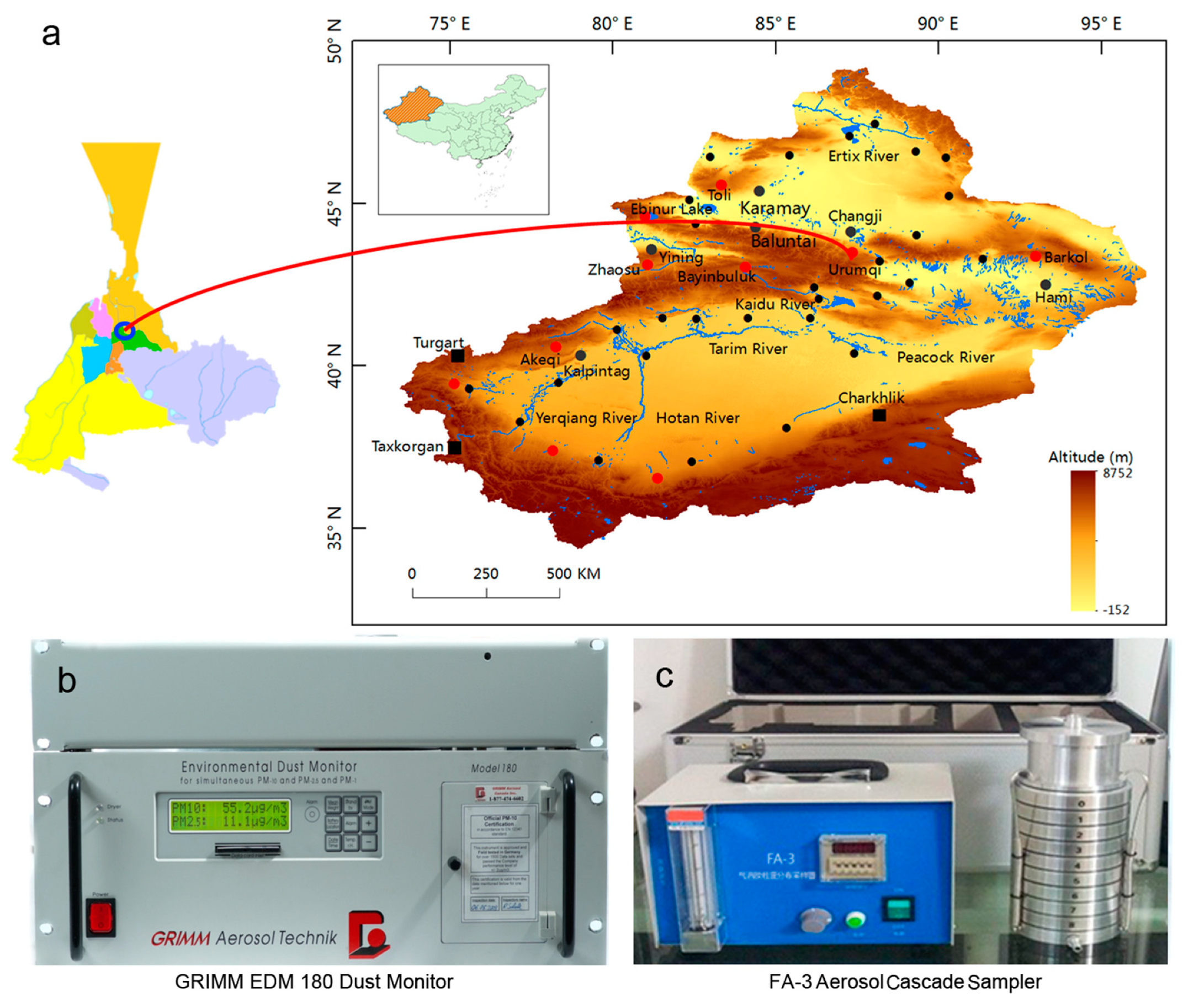
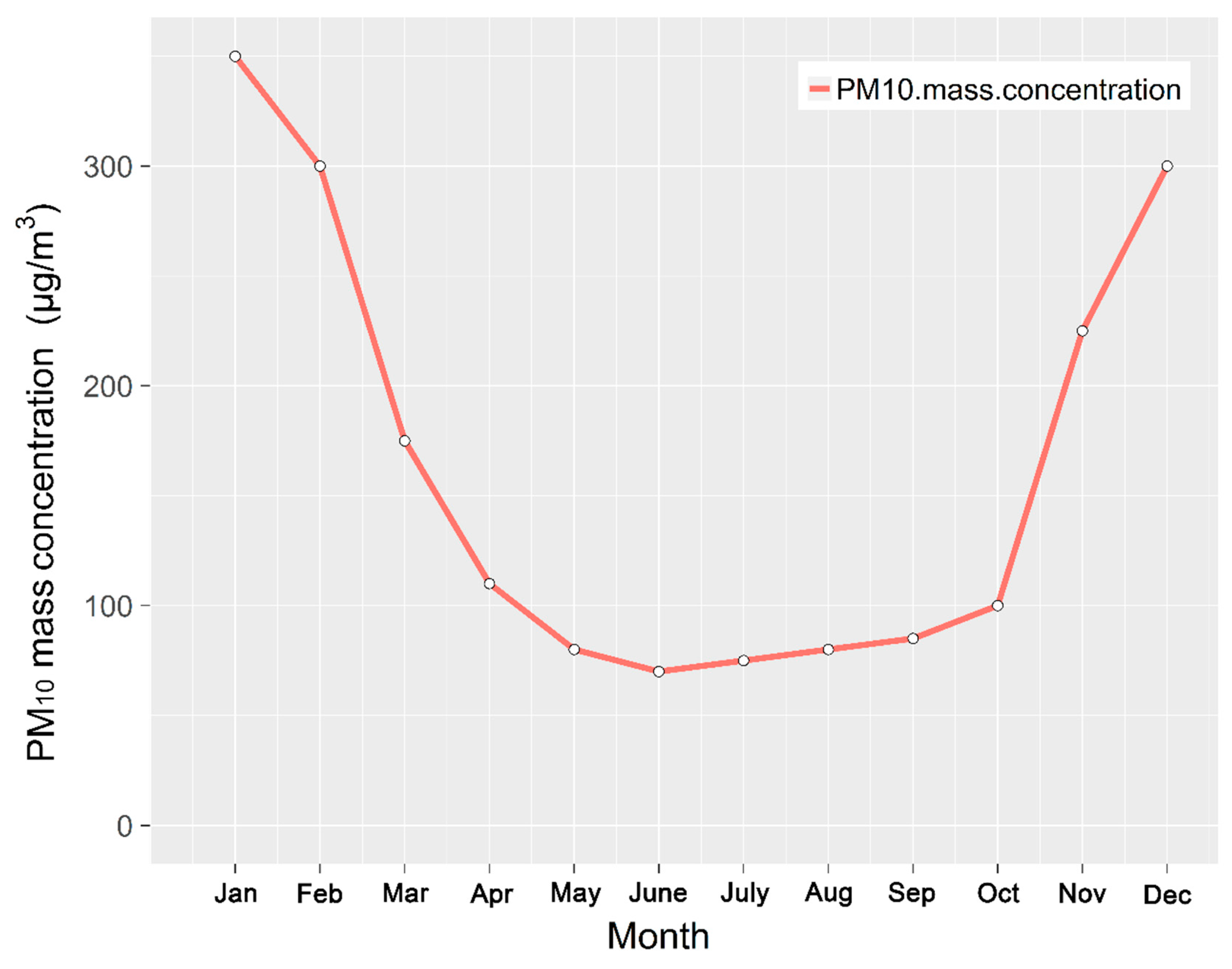

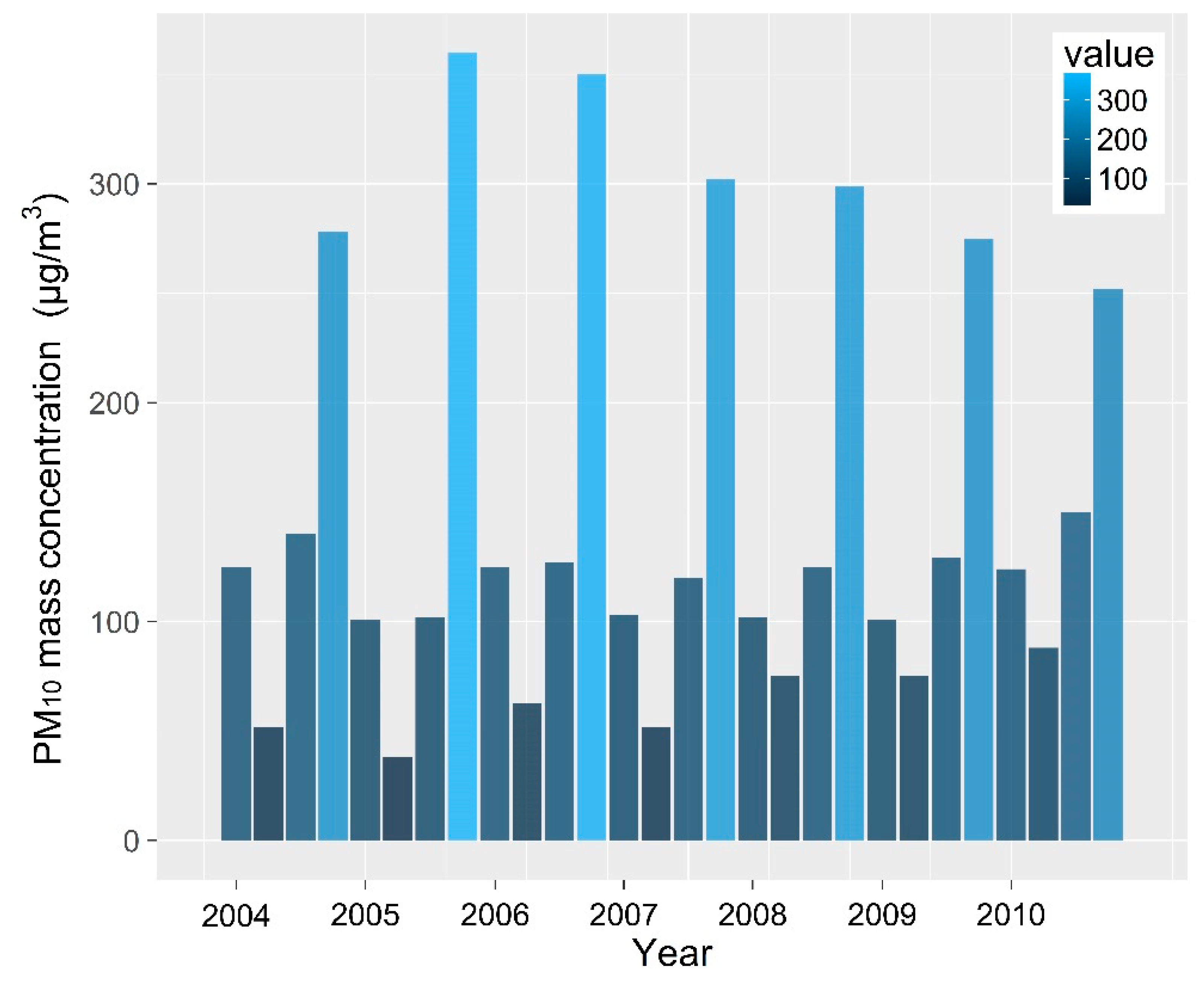
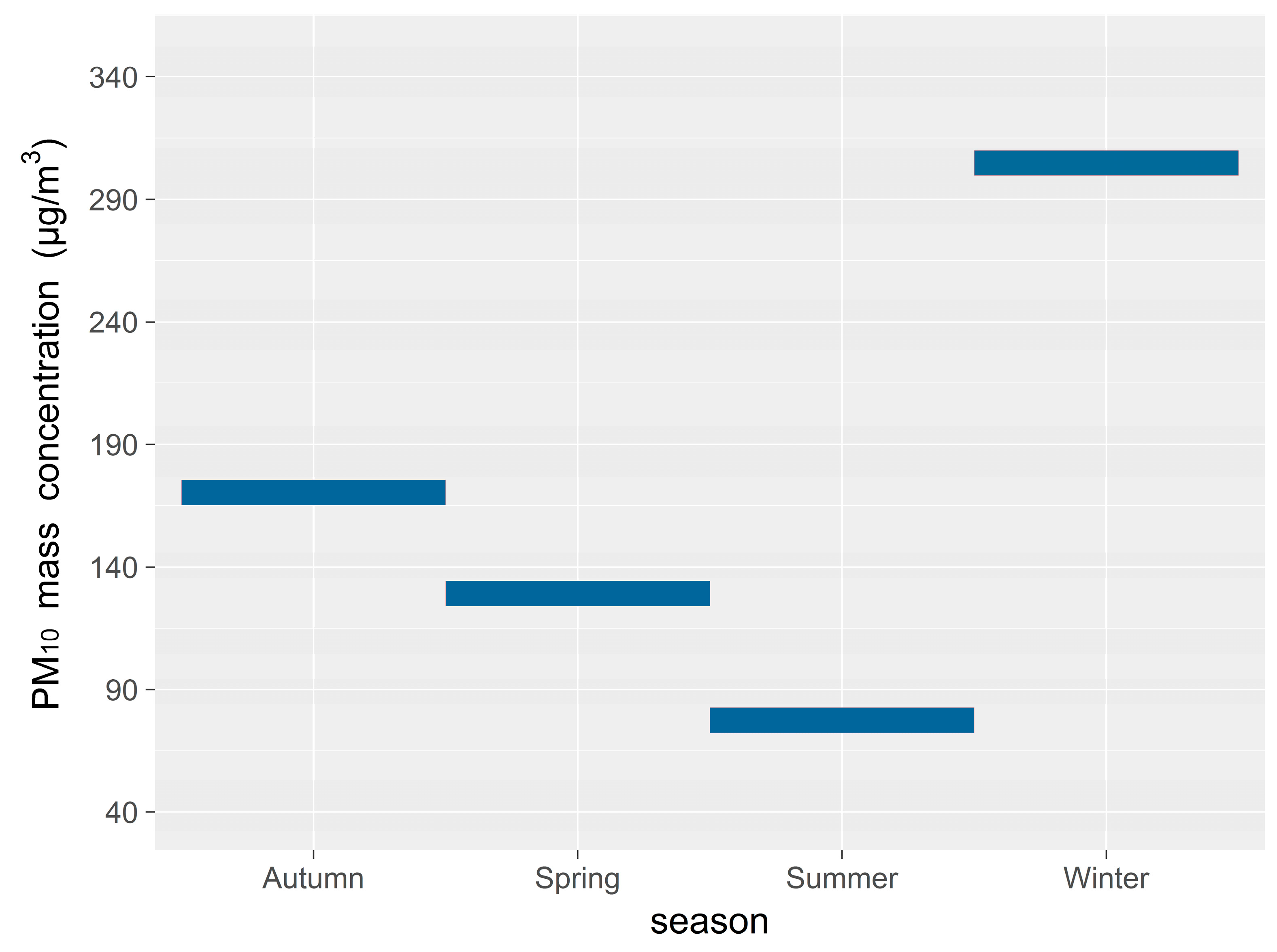


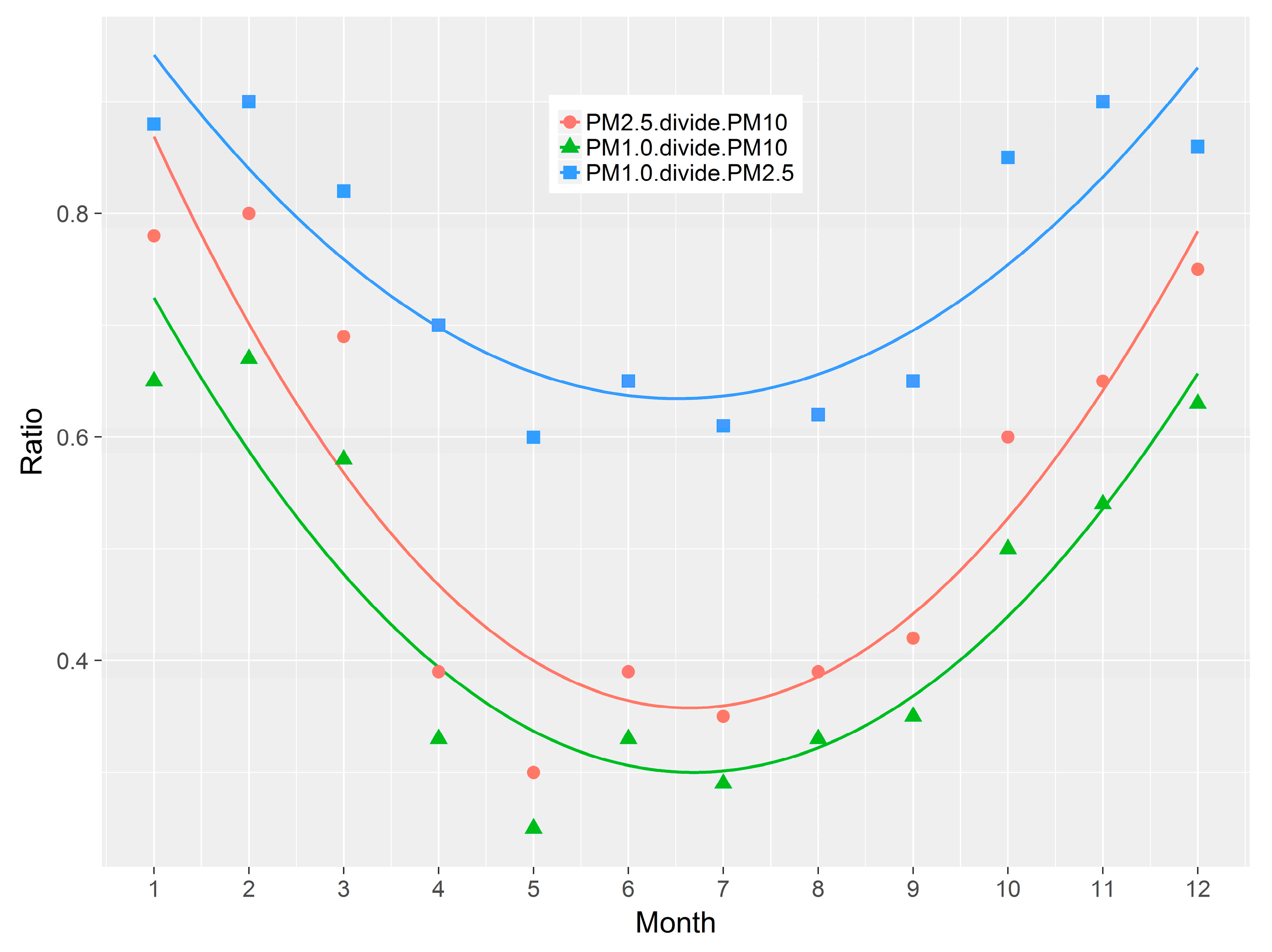

| API | <50 | 51–100 | 101–200 | 201–300 | 301–400 | 401–500 |
|---|---|---|---|---|---|---|
| Air quality grade | excellent | good | light pollution | moderate pollution | severe pollution | severe pollution |
| PM10 concentration | C = API R2 = 1.0 | C = 2API − 50 R2 = 1.0 | C = 2API − 50 R2 = 0.98 | C = 0.7API + 210 R2 = 0.99 | C = 0.8API + 180 R2 = 0.69 | C = API + 100 R2 = 1.0 |
| Year | Percentage of Total Number of Days *(%) | Average Daily Minimum Concentration (μg·m−3) | Average Daily Maximum Concentration (μg·m−3) | Average Annual Concentration (μg·m−3) | Standard Deviation (μg·m−3) |
|---|---|---|---|---|---|
| 2004 | 73.2% | 14 | 600 | 124.6 | 123.3 |
| 2005 | 69.9% | 15 | 600 | 119.3 | 140.6 |
| 2006 | 87.9% | 24 | 600 | 137.9 | 127.8 |
| 2007 | 89.0% | 24 | 600 | 141.3 | 124.7 |
| 2008 | 83.1% | 27 | 600 | 148.6 | 117.4 |
| 2009 | 89.3% | 18 | 600 | 144.3 | 116.9 |
| 2010 | 83.5% | 25 | 536 | 140.5 | 84.4 |
| Grades | 0 | 1 | 2 | 3 | 4 | 5 | 6 | 7 | 8 |
|---|---|---|---|---|---|---|---|---|---|
| Range | 9.0–10 μm | 5.8–9.0 μm | 4.7–5.8 μm | 3.3–4.7 μm | 2.1–3.3 μm | 1.1–2.1 μm | 0.7–1.1 μm | 0.43–0.65 μm | 100–1000 nm |
© 2019 by the authors. Licensee MDPI, Basel, Switzerland. This article is an open access article distributed under the terms and conditions of the Creative Commons Attribution (CC BY) license (http://creativecommons.org/licenses/by/4.0/).
Share and Cite
Meng, X.; Wu, Y.; Pan, Z.; Wang, H.; Yin, G.; Zhao, H. Seasonal Characteristics and Particle-size Distributions of Particulate Air Pollutants in Urumqi. Int. J. Environ. Res. Public Health 2019, 16, 396. https://doi.org/10.3390/ijerph16030396
Meng X, Wu Y, Pan Z, Wang H, Yin G, Zhao H. Seasonal Characteristics and Particle-size Distributions of Particulate Air Pollutants in Urumqi. International Journal of Environmental Research and Public Health. 2019; 16(3):396. https://doi.org/10.3390/ijerph16030396
Chicago/Turabian StyleMeng, Xianyong, Yiping Wu, Zhihua Pan, Hao Wang, Gang Yin, and Honggang Zhao. 2019. "Seasonal Characteristics and Particle-size Distributions of Particulate Air Pollutants in Urumqi" International Journal of Environmental Research and Public Health 16, no. 3: 396. https://doi.org/10.3390/ijerph16030396








